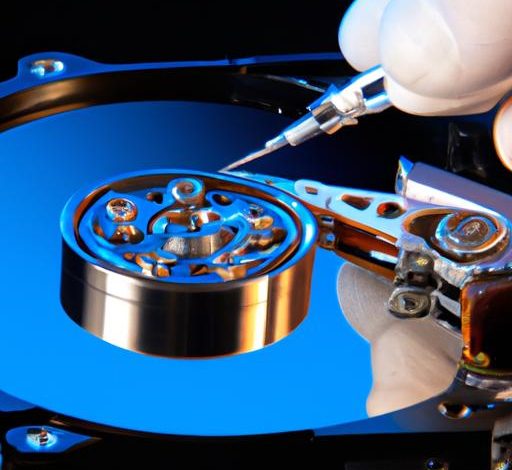Data Recovery Hard Drive: Safeguarding Your Precious Files

When it comes to our digital lives, the value of our data cannot be underestimated. We store countless memories, important documents, and vital information on our hard drives. But what happens when disaster strikes and our precious files are at risk of being lost forever? This is where data recovery for hard drives becomes crucial.
A. Importance of Data Recovery for Hard Drives
Imagine losing all your family photos, important work files, or years of research and data. The mere thought sends shivers down your spine, doesn’t it? This is why data recovery for hard drives is of utmost importance. It offers a lifeline, a chance to retrieve your invaluable information from the clutches of oblivion.
B. Brief Explanation of Data Recovery Process
So, how does data recovery work, you may ask? Well, it’s like being a detective on a mission to solve a complex puzzle. Data recovery involves retrieving lost or inaccessible data from storage media, such as hard drives, that have been damaged, corrupted, or accidentally deleted.
Whether it’s due to physical damage, accidental formatting, malware attacks, or power failures, our hard drives can be vulnerable to data loss. However, with the right techniques and tools, experts can delve deep into the intricate layers of your hard drive and salvage what seemed lost forever.
In the following sections, we’ll explore the common causes of data loss, understand the data recovery process, learn how to perform data recovery on hard drives, discover tips to prevent data loss, and reflect upon the importance of safeguarding our data. Let’s embark on this enlightening journey together and unlock the secrets of data recovery hard drive.
Common Causes of Hard Drive Data Loss
In the digital realm, there are numerous threats lurking around, ready to snatch away our precious data in the blink of an eye. To shield ourselves from these perils, it’s essential to understand the common causes of hard drive data loss.
A. Physical Damage: The Silent Destroyer
Picture this: a sudden drop, a hard knock, or even a natural disaster like a flood or fire. These unfortunate events can lead to physical damage to our hard drives, rendering them inoperable and our data inaccessible. It’s like a thief breaking into our home and stealing our cherished possessions.
B. Accidental Deletion or Formatting: Oops, It’s Gone!
We’ve all been there – that heart-stopping moment when we accidentally click the wrong button or format the wrong drive. Our important files vanish before our eyes, leaving us in a state of panic and disbelief. It’s like misplacing the key to a treasure chest, forever losing access to its valuable contents.
C. Virus or Malware Attacks: The Digital Intruders
In this interconnected world, malicious software is a constant threat. Viruses and malware can infiltrate our hard drives, corrupting files, encrypting data, or even completely wiping them out. It’s like a stealthy burglar sneaking into our digital haven, leaving behind chaos and devastation.
D. Power Surges or Failures: When the Lights Go Out
Power surges or sudden failures can strike without warning, disrupting the delicate balance within our hard drives. These erratic power fluctuations can cause data corruption, making it impossible to access our cherished files. It’s like a sudden blackout during a captivating movie, leaving us in the darkness with unfinished stories.
E. Operating System or Software Failures: The Glitch in the Matrix
Sometimes, our operating systems or software can encounter glitches or errors, resulting in data loss. Whether it’s a faulty update or a system crash, these unexpected mishaps can leave our hard drives in a state of disarray, making it challenging to retrieve our valuable information. It’s like a hiccup in the matrix, disrupting the smooth flow of our digital existence.
By understanding these common causes of hard drive data loss, we can take proactive measures to protect our files and ensure their recovery. Stay tuned as we delve deeper into the world of data recovery and uncover the secrets to reclaiming what was once lost.
Understanding Data Recovery for Hard Drives
In this digital age, where our lives revolve around technology, understanding the intricacies of data recovery for hard drives is essential. Let’s delve deeper into this fascinating realm and uncover the secrets that lie within.
A. Definition and Purpose of Data Recovery
Data recovery is the process of retrieving lost, deleted, or inaccessible data from storage media, like hard drives, in a way that restores its integrity and makes it accessible again. The purpose of data recovery is to salvage vital information that may have been accidentally deleted, lost due to hardware failure, or compromised by malicious software.
B. Different Types of Data Recovery Techniques
When it comes to data recovery for hard drives, there are two primary techniques that experts employ: logical data recovery and physical data recovery.
1. Logical Data Recovery
Logical data recovery focuses on retrieving data from drives that haven’t suffered physical damage. It involves using specialized software to scan the drive, locate the lost files by analyzing the file system, and then reconstruct and restore them.
2. Physical Data Recovery
Physical data recovery, on the other hand, comes into play when the hard drive has suffered physical damage, such as a mechanical failure or electronic component malfunction. This technique requires expert knowledge and specialized equipment to repair or replace the damaged components in a controlled environment, ensuring the safe retrieval of data.
C. Factors Affecting Successful Data Recovery
While the art of data recovery may seem like magic, several factors can influence its success. The severity of the damage, the storage media’s condition, the expertise of the data recovery specialist, and the time elapsed since the data loss can all impact the outcome. It’s crucial to seek professional help promptly and avoid any attempts at DIY recovery, as they may further jeopardize your chances of successful data retrieval.
Understanding these different data recovery techniques and the factors that influence their success will help you make informed decisions when faced with data loss. Now that we’ve explored the fundamentals, let’s move on to the practical steps involved in performing data recovery on hard drives.
Steps to Perform Data Recovery on Hard Drives
A. Evaluation and Diagnosis of the Hard Drive
Before diving into the data recovery process, it’s essential to evaluate and diagnose the condition of your hard drive. This step helps determine the extent of the damage and the chances of successful data recovery. Skilled professionals use specialized tools and techniques to examine the physical and logical aspects of the hard drive, identifying any underlying issues that may hinder the recovery process.
B. Choosing the Right Data Recovery Software or Service
Once the evaluation is complete, the next crucial step is selecting the appropriate data recovery software or service. With a myriad of options available, it’s essential to consider factors such as reliability, customer reviews, and the specific features offered. Whether you opt for a DIY software solution or prefer the expertise of a data recovery service provider, make sure to choose a reputable and trustworthy option to maximize your chances of successful data recovery.
C. Creating a Backup Image of the Hard Drive
Before initiating the data recovery process, it is highly recommended to create a backup image of the affected hard drive. This precautionary measure ensures that even if unforeseen circumstances arise during the recovery process, you have a secure copy of the original data. By creating a backup image, you preserve the integrity of the original drive while having a working copy to perform the recovery process.
D. Performing the Actual Data Recovery Process
With the evaluation, software selection, and backup image creation complete, it’s time to embark on the actual data recovery process. This step involves utilizing the chosen software or engaging the services of professionals who employ advanced techniques to retrieve your precious data. The process may vary depending on the specific circumstances, but it generally involves scanning the hard drive, identifying recoverable files, and extracting and restoring the lost data.
E. Verifying and Testing the Recovered Data
Once the data recovery process is complete, it is crucial to verify and test the recovered data for integrity and usability. Thoroughly examine the recovered files, ensuring they are intact and accessible. By performing comprehensive tests, you can confirm that the recovered data matches your expectations and that it is free from corruption or any further issues. This step provides peace of mind and ensures the successful retrieval of your valuable information.
By following these systematic steps, you can increase the chances of recovering your data successfully. Remember, patience and diligence are key throughout the process. Let’s move forward and explore valuable tips to prevent data loss on hard drives.
Tips for Preventing Data Loss on Hard Drives
A. Regularly Backup Important Data
One of the most effective ways to safeguard your data is by regularly backing it up. Think of it as creating a safety net for your valuable files. By making copies of your data and storing them in separate locations, you ensure that even if your hard drive fails, your information remains intact. Consider using external hard drives, cloud storage services, or automated backup software to simplify the process and provide peace of mind.
B. Implementing Reliable Antivirus Software
Viruses, malware, and other malicious threats can wreak havoc on your hard drive, leading to data loss. To protect yourself, it’s essential to implement reliable antivirus software. These programs act as guardians, scanning your files, emails, and downloads for any potential threats. With regular updates and real-time protection, they provide an additional layer of defense, preventing unauthorized access and minimizing the risk of data corruption or loss.
C. Avoiding Physical Damage to the Hard Drive
Your hard drive is a delicate piece of technology that requires proper care. Avoid subjecting it to physical damage by handling it with caution. Keep your computer in a secure location where it’s less likely to be bumped or knocked over. Additionally, ensure that your hard drive is properly installed and secured within your computer, using appropriate mounting techniques and protective casing if necessary. By taking these precautions, you can minimize the risk of physical damage that may result in data loss.
D. Maintaining Stable Power Supply
Power surges or sudden outages can be disastrous for your hard drive. They can disrupt data transfer processes, damage electronic components, and corrupt files. To reduce the risk, always use a reliable surge protector or uninterruptible power supply (UPS) to regulate the power supply to your computer. These devices absorb excess voltage and provide a consistent flow of electricity, protecting your hard drive from unexpected fluctuations and ensuring uninterrupted data access.
By following these tips, you can significantly reduce the chances of data loss on your hard drive. Remember, prevention is better than cure, and investing time and effort in data protection measures will pay off in the long run. Let’s move on to the final section and conclude our exploration of data recovery for hard drives.
Conclusion
In this digital age, where our lives are intertwined with technology, protecting our valuable data has become more crucial than ever. Data recovery for hard drives serves as a lifeline, allowing us to reclaim what seemed lost forever. From cherished memories to essential work files, the importance of data recovery cannot be overstated.
Throughout this article, we have explored the common causes of data loss on hard drives, understood the intricacies of the data recovery process, and learned essential steps to perform successful data recovery. We have also discussed preventive measures to safeguard our data, such as regular backups and implementing reliable antivirus software.
When faced with data loss, it’s essential to remain calm and seek professional help if necessary. Expert data recovery services possess the expertise, tools, and experience to maximize the chances of successful retrieval. Remember, your data is valuable, and it’s worth investing in its recovery.
At data.makethatpc.com, we understand the importance of your data and the impact it can have on your life. Our team of skilled professionals is dedicated to providing top-notch data recovery solutions for hard drives, ensuring that your precious files are rescued from the clutches of uncertainty.
Don’t let data loss define your digital journey. Safeguard your files, protect your memories, and trust data.makethatpc.com for all your data recovery needs. Together, let’s navigate the intricate world of data recovery and ensure that your valuable data remains safe and accessible for years to come.
Conclusion: So above is the Data Recovery Hard Drive: Safeguarding Your Precious Files article. Hopefully with this article you can help you in life, always follow and read our good articles on the website: data.makethatpc.com



